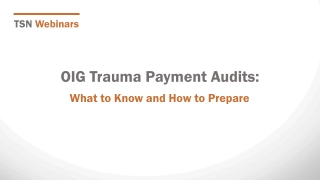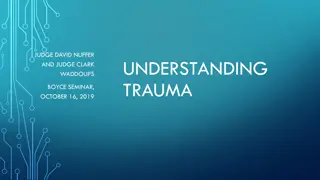Understanding PTSD and Trauma: A Comprehensive Overview
PTSD (Post-Traumatic Stress Disorder) is a clinical diagnosis that develops following exposure to a distressing event. Trauma describes something with a significant emotional impact. PTSD symptoms include re-experiencing, avoidance, hyperarousal, and emotional numbing. Complex PTSD (CPTSD) involves disturbances in self-organization. Treatment and support are crucial for individuals affected by trauma or PTSD.
Download Presentation

Please find below an Image/Link to download the presentation.
The content on the website is provided AS IS for your information and personal use only. It may not be sold, licensed, or shared on other websites without obtaining consent from the author. Download presentation by click this link. If you encounter any issues during the download, it is possible that the publisher has removed the file from their server.
E N D
Presentation Transcript
UNDERSTANDING PTSD (Post Traumatic Stress Disorder)
Trauma vs PTSD PTSD is a clinical diagnosis Trauma is a term to describe something that has had a significant emotional impact on someone. Trauma is defined in the English dictionary as: a deeply distressing or disturbing experience an emotional shock following a stressful event or physical injury . If someone has experienced a trauma and is affected emotionally by it, yet do not meet the diagnostic criteria for PTSD, this does not mean that they should be excluded from treatment or do not require it.
Sowhat is PTSD? Develops following exposure to a stressful event or situation of exceptionally threatening or horrific nature likely to cause pervasive distress in almost anyone (ICD- 11). Around 25-30% people experiencing a traumatic event go on to develop PTSD. Studies around the world show varying prevalence's of PTSD ranging between 1-12%. Usually develops right after the traumatic experience however in some cases the onset of symptoms may be delayed.
o Re-experiencing involuntary re-experiencing of the event flashbacks, acting or feeling as if the event is reoccurring being back there . Nightmares. Repetitive and distressing intrusive images. Ruminating questions about the event, what could have prevented it, been done differently etc.
Avoidance - People - Places - Situations, conversations, circumstances associated with the event - Trying to avoid thinking or talking about it - Trying to push or erase it from the mind
Hyper arousal, reactivity or sense of current threat - Physiological reactions anxiety, sweating, pounding heart - Hypervigilance for threat - Exaggerated startle response - Irritability, trouble concentrating - Trouble sleeping Emotional Numbing - Feeling detached - Difficulty experiencing feelings - Amnesia from certain parts of the event - Giving up previous activities that were significant
Wellbeing and Recovery College Complex PTSD (CPTSD) New diagnosis in ICD-11 diagnostic criteria In addition to the 3 core elements of PTSD (re- experiencing, avoidance and hypervigilance/sense of current threat) are the following: - disturbances in self-organisation that are pervasive and occur across various contexts - 1) Emotional regulation, such as difficulty calming down - 2) Negative self-concept, for example beliefs about self as worthless or a failure - 3) Relationship difficulties, such as avoidance of -
Anxiety flight, fight or freeze response The Fight Flight Freeze Response - YouTube http://www.getselfhelp.co.uk/ docs/Adrenaline.pdf
Why do some people get PTSD? It is thought that the natural process has got stuck - A traumatic event being sudden, unexpected, causing many deaths, going on for a prolonged period of time and/or causing mutilation or more likely to result in PTSD involving children is - There are different functions that may be involved in causing PTSD such as adrenaline remaining high due to the vivid memories of the traumatic event - Hippocampus part of the brain that processes memories; it is believed that high levels of stress hormones may stop it from working. Brain Model of PTSD - Psychoeducation Video - YouTube
Treatment Subthreshold symptoms than 4 weeks after the trauma active monitoring, follow up within 1 Month Moderate to severe symptoms within 1 Month of trauma offer individual trauma-focused (TF) CBT intervention: Cognitive processing therapy, cognitive therapy for PTSD, narrative exposure therapy, prolonged exposure therapy. No guidance on no. sessions. Diagnosis of PTSD or clinically important symptoms of PTSD, presenting more than 1 Month after the traumatic event individual TF CBT intervention (as above), EMDR Therapy (exception of combat related trauma). 8-12 of sessions of either, may require more. Supported trauma-focused computerised CBT intervention can be considered if preferred to above TF CBT or EMDR Therapy if presenting 3 Months or more after traumatic event. 8-10 sessions typically. CBT interventions targeting specific PTSD symptoms like sleep disturbance or anger can be offered (after 3 months of traumatic event) only if the person is unable or unwilling to engage with above mentioned interventions, or has residual symptoms after a trauma-focused intervention has been completed. NICE 2021
Psychological therapies Trauma-focused Cognitive behavioural therapy (CBT) www.babcp.com for further info Eye Movement Desensitisation re-processing (EMDR) Therapy. www.emdrassociation.org.uk for further info Supported Computerised trauma-focused CBT
Medication Anti-depressants may be prescribed - Venlafaxine or an SSRI, such as Sertraline if the person has preference for drug treatment. Must be monitored regularly. Sometimes anti-psychotics can help when anxiety levels are extremely high, such as risperidone - in addition to psychological therapies. If psychotic symptoms or severe hyperarousal are present, or symptoms not responded to other drug or psychological treatments. Tranquillisers and sleeping tablets should be avoided Trauma-focused therapies should usually be offered first prior to medication in most cases.
What can someone suffering from trauma or PTSD do to help themselves? Seek help and support from friends and family, talk to someone you are comfortable with and trust. If this is not possible seek professional support. If possible try to resume a normal routine. Eat regularly and exercise often/engage in sport. Alternative therapies such as Tai Chi, reflexology, massage, acupuncture can help focus on the here and now more rather than the past. Relaxation Mindfulness Music
Positive self talk and distraction When experiencing traumatic memories and images, remind yourself. - this is in the past, it is over now - although it still distresses me I got through it, I can be strong - these are just feelings and although they are unpleasant they will pass Focus on the present distraction, go for a walk, call a friend for a general chit chat, engage in a hobby/something you enjoy
Friends, family and colleagues how to be supportive Allow the trauma survivor to tell their story, let them talk, don t interrupt the flow or compare with your own experiences Watch for changes in their behaviour, anger, irritability, low mood, lack of interest Don t tell them you know how they feel or that they are lucky to be alive Don t minimise their experience it s not that bad or suggest things like get over it or pull yourself together .
Progressive muscle relaxation exercise Bensons Relaxation practical Sit in a comfortable position and adopt a relaxed posture Pick a short focus word that has significant meaning for you and that you associate with relaxation (e.g. relax, smooth, calm, easy, float, etc.) Slowly close your eyes Relax all the muscles in your body Breathe smoothly and naturally, repeating the focus word Be passive so that if other thoughts enter your mind, dismiss them with, 'Oh well' and calmly return to the focus word - do not concern yourself with how the process is going Continue this for 10 to 15 minutes as required.























